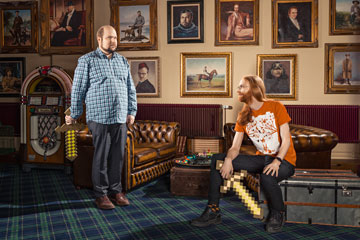
Persson, far left, and Bergensten, the minds behind Minecraft, brandishing the game's pixelated swords
Since December 2011, Jacob Granberry and Will Blew have been overseeing a land-development effort of truly epic proportions. Covering more territory than the city of Los Angeles, it's about 70% complete and already contains about 8,000 structures. It's so sprawling and ambitious, though, that nobody knows for sure just what's there. "I haven't seen near everything, and I started the damn project," says Granberry.
Their undertaking happens to be a digital re-creation of Westeros, the fabled continent from George R.R. Martin's A Song of Ice and Fire books and the HBO series based upon them, Game of Thrones. And they happen to be creating all those castles, towers, farmhouses, shops and ships in Minecraft, the online game from a Swedish start-up named Mojang that's inspiring millions of people of all ages to go on building sprees. This virtual Westeros may be exceptional in scale--more than 500 volunteers have participated in its creation so far--but it's also utterly typical of Minecraft. True, if all you want from a game is the ability to wander around a kingdom slaughtering zombies with a sword, you can get that from Minecraft. Millions do, and the game might have been a hit if that were all it offered.
But it isn't destruction that makes Minecraft unique. It's construction. The game is a Disneyland where the attractions are built by visitors. (Sometimes literally: players have painstakingly re-created the Anaheim, Calif., theme park, complete with working rides.) Think of a notable real or fictional locale, from Rockefeller Center to Hogwarts, and the odds are pretty good that there's a spectacular rendition of it in Minecraft. Maybe several. Plenty of players use it to imagine worlds that exist nowhere else. And everything's made out of blocks measuring one cubic meter apiece.
Now, insanely addictive video games, it's fair to say, usually don't have fabulous reputations among the unaddicted. At best they may be regarded as irritating time sinks (Farmville), at worst as potential threats to society (any violent game allegedly played by someone who turns out to be a mass murderer). Minecraft is different. The deeper you get into it, the more it looks like a form of self-education masquerading as entertainment, which is why parents tend not to see it as a scourge and teachers are bringing it into the classroom. "It follows rules, just like the real world," says Mark Frauenfelder, the editor of Make magazine, the bible of the do-it-yourself hobbyists of all ages who make up the thriving maker movement. "You put together materials with varying properties. You have to be aware of physics. You have to understand levers and ramps and can even build electric circuits."
No less lofty an authority than the United Nations sees Minecraft as a tool to improve human life. Last September, its U.N.-Habitat agency teamed up with Mojang to launch a program called Block by Block. It will use Minecraft to digitally reimagine 300 run-down public spaces in the next three years, giving people who live near them the chance to chime in on how they might be improved. First up: a dilapidated park in Nairobi's business district and parts of its Kibera slum. "Someone says, 'Ah, we'd like to have a skateboard ramp,'" says U.N.-Habitat's Thomas Melin. "And click, click, click, there's a skateboard ramp."
